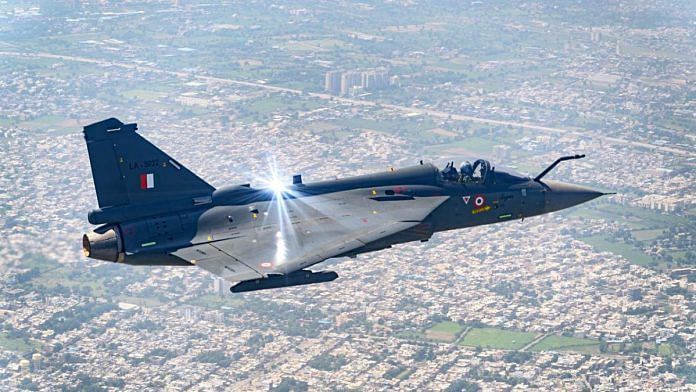New Delhi: Defence Research and Development Organisation (DRDO) successfully conducted high-altitude trials of the indigenous On-Board Oxygen Generating System (OBOGS)-based Integrated Life Support System (ILSS) for the LCA Tejas aircraft Tuesday.
The OBOGS-based ILSS is designed to generate and regulate breathable oxygen for pilots during flight, doing away with the dependence on traditional liquid oxygen cylinder-based systems.
The ILSS underwent testing on the LCA-prototype Vehicle-3 aircraft. The DRDO said in a statement that it met stringent aeromedical standards in varied flight conditions, including altitudes of up to 50,000 feet above mean sea level and high-G manoeuvres.
The performance evaluation of the ILSS included rigorous tests, such as oxygen concentration, demand breathing, availability of 100 percent oxygen and aerobatic manoeuvres at various altitudes.
ILSS integrates multiple components, including the Low-Pressure Breathing Regulator and Anti-G valve, to ensure real-time oxygen generation, enhancing pilot endurance and operational effectiveness.
The system has been manufactured by L&T as DRDO’s development-cum-production partner.
It has 90 percent indigenous content, the DRDO statement said. “With appropriate modifications, the system can also be adapted for use in MiG-29K and other aircraft. This milestone has been achieved through the collaborative efforts of DEBEL (Defence Bio-Engineering and Electro Medical Laboratory), ADA (Aeronautical Development Agency), HAL (Hindustan Aeronautics Limited), CEMILAC (Centre for Military Airworthiness & Certification), National Flight Test Center, Directorate General of Aeronautical Quality Assurance, and the Indian Air Force (IAF),” it read.
By generating oxygen onboard, OBOGS allows aircraft to stay airborne for extended periods. OBOGS is often integrated into ILSS—to ensure comprehensive physiological protection to aircrew during high-altitude and high-speed flights. This system includes backup oxygen systems to ensure safety during emergencies.
OBOGS uses a technology known as the ‘zeolite molecular sieve’, which separates oxygen from air, providing a reliable and efficient method for oxygen generation.
The Rafale fighter aircraft is also fitted with an OBOGS, which suppresses the need for liquid oxygen re-filling, eliminating the need for ground support equipment for the production and transportation of oxygen. The fighter is equipped with OBOGS developed by Air Liquide.
It eliminates the need for liquid oxygen canisters by utilising bleed air from the aircraft’s engines, and separating its components using molecular sieve technology.
Currently, Rafale—the latest entrant into the Air Force’s inventory, is the only aircraft to have such a system. All older aircraft operate on liquid oxygen canisters.
An OBOGS prototype was first flown on a Mirage 2000 in 1989, marking an early stage in the development of this technology for military aircraft. A year later, Dassault decided to equip Rafales with this technology.
The Saab JAS 39 Gripen, a multi-role fighter aircraft which is one of the contenders for India’s MRFA programme, features an OBOGS in its C and D variants. The JAS 39C and D models were introduced as part of the third batch of Gripens, including OBOGS as a standard feature.
While OBOGS is standard for later Swedish models, it is optional for export variants of the Gripen.
By minimising the use of high-pressure oxygen systems, OBOGS reduces the risk of accidents and injuries associated with handling these systems. This enhances both aircraft and maintenance safety.
Some of the most modern aircraft, some of which are contenders for IAF’s 114 multi-role fighter jet programme, have been fitted with OBOGS. The F/A 18, F16 and F21 also are equipped with these systems.
(Edited by Mannat Chugh)






